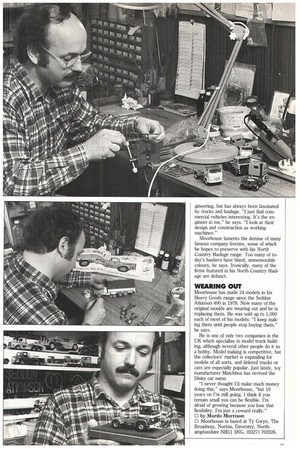MINIATUR MARVELS
Page 46

Page 47

If you've noticed an error in this article please click here to report it so we can fix it.
Model maker Geoff Moorhouse specialises in recreating classic trucks of the seventies, complete with authentic liveries and in amazing detail.
M Big J Guys, Scammell Crusaders and other stalwart trucks of the seventies live on in the models of Geoff Moorhouse. He specialises in recreating working trucks from that era, many with detail-perfect liveries of haulage firms like Thames of Thurgoland or Crooks of Southport.
The Daventry-based former toy-car designer has been making his models for 10 years. He attributes their popularity to nostalgia for the "decline of British Industry", and for home-grown HGVs which, he recalls, "everyone thought were heaps of rust at the time".
Moorhouse bases his models on photographs of working vehicles which he often spots on the road and tracks down. He is always looking for enthusiasts to send him pictures of seventies-built trucks with eye-catching liveries.
PERFECT SCALE
The latest addition to the range is a Big J Guy in the colours of Swift-ways of Coleshill, Warwickshire: a company recently featured in Commercial Motor (1-7 September), The trucks, which have been on the road for 20 years, are being replaced, but now they will be preserved for posterity as perfect scale models.
Moorhouse, 39, joined model manufacturer Meccano in 1972 after leaving Liverpool Polytechnic. Then the toy industry slumped, and "I went with it". His first full product range, Heavy Goods, celebrates its 10th anniversary next year, and his first new model since 1983, a Scammell Crusader, is out this month.
Moorhouse rarely goes back further than the seventies for inspiration — the only exception was a 1952 Albion which was "a bit of an oddball".
His first model was a 1975 Seddon Atkinson 400 tractive unit (he made it in 1977), but the most popular to date has been a Scania Vabis LB76.
His North Country Haulage range, which uses genuine liveries, includes a Volvo F88 in the colours of D Park and Son; an Atkinson tractive unit liveried Holt Lane Transport, and Atkinson Borderers in the liveries of Smiths of Lye, Killingbeck of Blackburn andThorpes of Thurgoland.
The Heavy Goods series is even more extensive and includes an Albion HP57, a Fiat 170, a Scania R142 and a Magirus 256M. He has also made trailers — a Crane Fruehauf two-axle and a Tasktip two-axle among them. Moorhouse's business almost went to the wall when some major orders for kits fell through, and last year he decided to cut costs by handling his own casting and production. This has made smaller runs easier and provided the impetus for his original-livery North Country Haulage range.
Plans include models of the Big J Guy and the Leyland Marathon, and a reissue of the Seddon Atkinson 400, the Volvo F86 and Volvo F82. Suggestions or help, in the form of photos, drawings or brochures would be welcomed.
Making the trucks is a painstaking process. Moorhouse's workshop is packed with half-built models, technical drawing boards and photographs of lorries.
RISKS OF EXPANSION
He could obviously use more space, but in the tiny commuter village where he stays, this is impossible. An industrial estate unit would be ideal, but Moorhouse is well aware of the risks of expansion, and is wary of taking on any helpers: "I've tried, but I'd have to train them. I've never had enough money and I haven't found anyone of a high enough standard," he says.
Making the pieces for his kits, including moulding them from white metal, is a three-stage process. He claims he is the only modelmaker to make a one-piece cab, using a technique he developed himself.
The Continent, Holland especially, remains the biggest market for Moorehouse's models, but he hopes his North Country Haulage range, in original operator's colours, will tempt more home enthusiasts. Unlike foreign manufacturers like Scania and Volvo, however, few UK truck makers have been keen on using models for promotions.
The scale Moorhouse uses for his models is 1:50. This used to be the only size of model lorry made, loosely based on a quarter-inch to one foot. Now it represents an exact lmm to 50rnm. It is just big enough to include detail, says Moorhouse.
He has never been in road haulage although he qualified in mechanical en gineering, but has always been fascinated by trucks and haulage. "I just find commercial vehicles interesting. It's the engineer in me," he says. "I look at their design and construction as working machines."
Moorhouse laments the demise of many famous company liveries, some of which he hopes to preserve with his North Country Haulage range. Too many of today's hauliers have bland, unmemorable colours, he says. Ironically, many of the firms featured in his North Country Haulage are defunct.
WEARING OUT
Moorhouse has made 24 models in his Heavy Goods range since the Seddon Atkinson 400 in 1978. Now many of the original moulds are wearing out and he is replacing them. He was sold up to 1,000 each of most of his models: "I keep making them until people stop buying them," he says.
He is one of only two companies in the UK which specialise in model truck building, although several other people do it as a hobby. Model making is competitive, but the collectors' market is expanding for models of all sorts, and deleted trucks or cars are especially popular. Just lately, toy manufacturer Matchbox has revived the Dinky car name.
"I never thought I'd make much money doing this," says Moorhouse, "but 10 years on I'm still going. I think if you remain small you can be flexible. I'm afraid of growing because you lose that flexibility. I'm just a coward really." 0 by Murdo Morrison
Moorhouse is based at Ty Gwyn, The Broadway, Norton, Daventry, Northamptonshire NH11 5NG, (0327) 702326.
















































